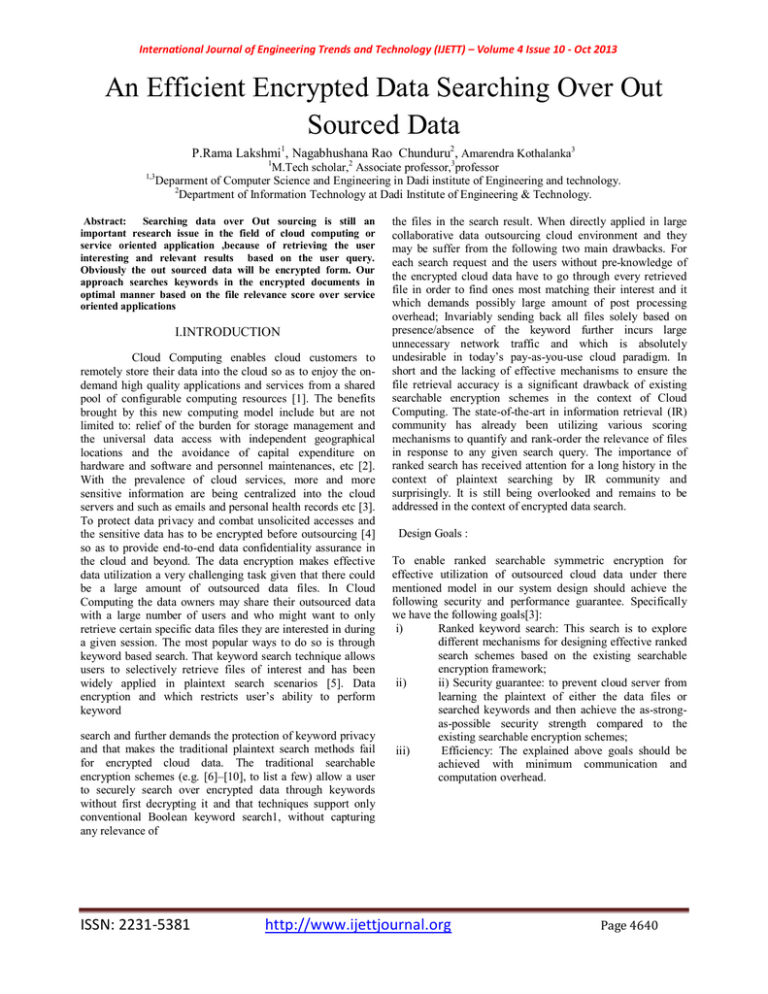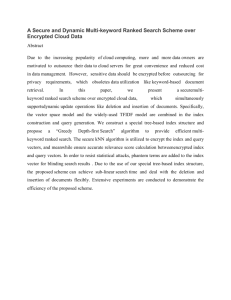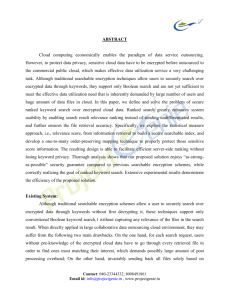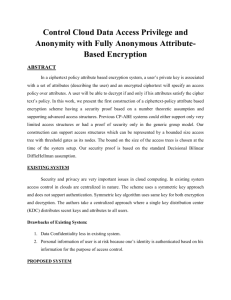An Efficient Encrypted Data Searching Over Out Sourced Data P.Rama Lakshmi
advertisement

International Journal of Engineering Trends and Technology (IJETT) – Volume 4 Issue 10 - Oct 2013
An Efficient Encrypted Data Searching Over Out
Sourced Data
P.Rama Lakshmi1, Nagabhushana Rao Chunduru2 , Amarendra Kothalanka3
1
M.Tech scholar,2 Associate professor,3professor
Deparment of Computer Science and Engineering in Dadi institute of Engineering and technology.
2
Department of Information Technology at Dadi Institute of Engineering & Technology.
1,3
Abstract:
Searching data over Out sourcing is still an
important research issue in the field of cloud computing or
service oriented application ,because of retrieving the user
interesting and relevant results based on the user query.
Obviously the out sourced data will be encrypted form. Our
approach searches keywords in the encrypted documents in
optimal manner based on the file relevance score over service
oriented applications
I.INTRODUCTION
Cloud Computing enables cloud customers to
remotely store their data into the cloud so as to enjoy the ondemand high quality applications and services from a shared
pool of configurable computing resources [1]. The benefits
brought by this new computing model include but are not
limited to: relief of the burden for storage management and
the universal data access with independent geographical
locations and the avoidance of capital expenditure on
hardware and software and personnel maintenances, etc [2].
With the prevalence of cloud services, more and more
sensitive information are being centralized into the cloud
servers and such as emails and personal health records etc [3].
To protect data privacy and combat unsolicited accesses and
the sensitive data has to be encrypted before outsourcing [4]
so as to provide end-to-end data confidentiality assurance in
the cloud and beyond. The data encryption makes effective
data utilization a very challenging task given that there could
be a large amount of outsourced data files. In Cloud
Computing the data owners may share their outsourced data
with a large number of users and who might want to only
retrieve certain specific data files they are interested in during
a given session. The most popular ways to do so is through
keyword based search. That keyword search technique allows
users to selectively retrieve files of interest and has been
widely applied in plaintext search scenarios [5]. Data
encryption and which restricts user’s ability to perform
keyword
search and further demands the protection of keyword privacy
and that makes the traditional plaintext search methods fail
for encrypted cloud data. The traditional searchable
encryption schemes (e.g. [6]–[10], to list a few) allow a user
to securely search over encrypted data through keywords
without first decrypting it and that techniques support only
conventional Boolean keyword search1, without capturing
any relevance of
ISSN: 2231-5381
the files in the search result. When directly applied in large
collaborative data outsourcing cloud environment and they
may be suffer from the following two main drawbacks. For
each search request and the users without pre-knowledge of
the encrypted cloud data have to go through every retrieved
file in order to find ones most matching their interest and it
which demands possibly large amount of post processing
overhead; Invariably sending back all files solely based on
presence/absence of the keyword further incurs large
unnecessary network traffic and which is absolutely
undesirable in today’s pay-as-you-use cloud paradigm. In
short and the lacking of effective mechanisms to ensure the
file retrieval accuracy is a significant drawback of existing
searchable encryption schemes in the context of Cloud
Computing. The state-of-the-art in information retrieval (IR)
community has already been utilizing various scoring
mechanisms to quantify and rank-order the relevance of files
in response to any given search query. The importance of
ranked search has received attention for a long history in the
context of plaintext searching by IR community and
surprisingly. It is still being overlooked and remains to be
addressed in the context of encrypted data search.
Design Goals :
To enable ranked searchable symmetric encryption for
effective utilization of outsourced cloud data under there
mentioned model in our system design should achieve the
following security and performance guarantee. Specifically
we have the following goals[3]:
i)
Ranked keyword search: This search is to explore
different mechanisms for designing effective ranked
search schemes based on the existing searchable
encryption framework;
ii)
ii) Security guarantee: to prevent cloud server from
learning the plaintext of either the data files or
searched keywords and then achieve the as-strongas-possible security strength compared to the
existing searchable encryption schemes;
iii)
Efficiency: The explained above goals should be
achieved with minimum communication and
computation overhead.
http://www.ijettjournal.org
Page 4640
International Journal of Engineering Trends and Technology (IJETT) – Volume 4 Issue 10 - Oct 2013
II. RELATED WORK
Algorithm for index table generation:
Now a day’s secure data storage over cloud servers is an
important research issue in the field of cloud computing, Even
though various traditional approaches are there for cloud
storage, but they are not optimal, because many of the
traditional mechanisms are not optimal for data correctness,
integrity and dynamic data support.
In Cloud, To ensure users that their data are indeed stored
appropriately and kept intact all the time in the service. In this
Module Data can be divided in to number of chunks and
performs encryption on the block of packets for the security
and correctness.
To maintain the same level of storage correctness assurance
even if users modify, delete, or append their data files in the
cloud. In this module various verification mechanisms are
introduced for modify, delete and append operations.
User: an entity, who has data to be stored in the cloud and
relies on the cloud for data storage and computation, can be
either enterprise or individual customers.
.Cloud Server (CS): an entity, which is managed by cloud
Service provider (CSP) to provide data storage service and
has significant storage space and computation resources
.
Third-Party Auditor: an optional third party auditor, who has
expertise and capabilities that users may not have and it is
trusted to assess and expose risk of cloud storage services on
behalf of the users upon request.
III.PROPOSED SYSTEM
In this approach data owner out sources the data in
the server, before storing data in the server , Data owner has a
collection of n data files C = (F1,F2, …, Fn) that he wants to
outsource on the server in encrypted form while still keeping
the capability to search through them for effective data
utilization reasons. The data owner will first build a secure
searchable index I from a set of m distinct keywords W =
(w1,w2, …,wm) extracted from the file collection C and store
the index I and the encrypted file collection C on the server.
After searching the information data can be organized after
the ranking.
Before outsourcing the data owner will first build a
secure searchable index I from a set of m distinct keywords W
= (w1,w2…,wm) extracted from the file collection C.Index
table contains the unique keywords from the datasets along
with file ids, before placing them into the index table encrypt
the keywords by using symmetric key approach with AES
algorithm for security purpose.
ISSN: 2231-5381
Srep1. Read the document F
Step2. Segment the document term wise and encrypt with key
Step3. Calculate term frequency (TF) and inverse document
frequency(IDF) and publishing time(PT)
Step4. Generate index table(Itable) and files upload to server
Rijandael algorithm
Rijandael is an efficient and secure cryptographic algorithm
regarding computational complexity issues also. Rijandael
developed to resolve the drawbacks in DES algorithm. It is a
block cipher algorithm.
Key Expansion
Key can be generated by the key schedule of rijandael key
schedule. AES requires a separate 128-bit round key block for
each round plus one more.
Add Round Key: every individual byte of the state in each
byte of the state is integrated with the round key using bitwise
xor Rounds
Sub Bytes: By using the lookup table every byte can be
replaced by another with respect to the table non-linear
substitution way.
Shift Rows: Each row of the block transposed cyclically with
certain number of steps.
Mix Columns: Mixing operation which operates on the
columns of the state, combining the four bytes in each
column.
AddRoundKey
1. Final Round (no MixColumns)
1. SubBytes
2. ShiftRows
3. AddRoundKey
Complete implemention of the subbytes,shiftrows,mix
columns and add round key as follows[16], for
implementation details we had used builtin algorithm from the
dotnet namespaces.
http://www.ijettjournal.org
Page 4641
International Journal of Engineering Trends and Technology (IJETT) – Volume 4 Issue 10 - Oct 2013
Sub Bytes:
In the SubBytes step, each byte ai,j in the state matrix is
replaced with a SubByte S(ai,j) using an 8-bit substitution box,
theRijndael S-box. This operation provides the non-linearity
in the cipher. The S-box is used derived from multiplicative
inverse overGF(28), known to have good non-linearity
properties. To reduce the attacks based on simple algebraic
properties and the S-box is constructed by combining the
inverse function with an invertible transformation. The S-box
is chosen to avoid any fixed points (and so is a derangement),
i.e.,S(ai,j)≠ a i,j , and also any opposite fixed points, i.e.,
S(ai,j)⨁ ai,j≠ 0xFF.
Shift rows:
The Shift Rows step operates on the rows of the state; it
cyclically shifts the bytes in each row by a certain offset. For
AES first row is left unchanged. Every byte of the second row
is shifted one to the left. As same as previous step, the third
and fourth rows are shifted by offsets of two and three
respectively. For blocks of sizes 128 bits and 192 bits and the
shifting pattern is the same. Row n is shifted left circular by
n-1 bytes. Similarly each column of the output state of
the Shift Rows step is composed of bytes from each column
of the input state. For a 256-bit block, the first row is
unchanged and the shifting for the second, third and fourth
row is 1 byte, 2 bytes and 3 bytes respectively—this change
only applies for the Rijndael cipher when used with a 256-bit
block as same as AES does not use 256-bit blocks. The
importance of this step is making the columns not linear
independent and AES becomes four independent block
ciphers.
In more general sense, each column is treated as a polynomial
over GF(28) and is then multiplied modulo x4+1 with a fixed
polynomial c(x) = 0x03 · x3 + x2 + x + 0x02. The coefficients
are displayed in their hexadecimal equivalent of the binary
representation of bit polynomials from GF(2)[x]. The Mix
Columns step also viewed as multiplication by a
particular MDS matrix in a finite field. This method is
described further in the article Rijndael mix columns.
AddRoundKey
In the AddRoundKey step, the subkey is combined
with the state. For every round a sub key is derived from the
main key using Rijndael's key schedule; each subkey is the
same size as the state. Sub key is added by combining each
byte of the state with the corresponding byte of the subkey
using bitwise XOR.
Our proposed Architecture works with web services
(service oriented applications) ,that provides the language
interoperability and security. The Server receives the query
from the user and it encrypts the query by using AES
algorithm and authenticates himself with the user key and
compares with the encrypted keyword in the index table, finds
the number of occurrences of the keyword,
Service provider
Data owner
Index tables
User
Query
Rank oriented
results
Out sources
with Index table
MixColumns step
In the Mix Columns step, the four bytes of each column of the
state are combined using an invertible linear transformation.
The Mix Columns function takes four bytes as input and
outputs four bytes and each input byte affects all four output
bytes. Together with Shift Rows, Mix Columns provide
a diffusion in the cipher.
During this operation, each column is multiplied by the
known matrix that for the 128-bit key is:
Architechture
that determines the term frequency and inverse document
frequency for finding the file relevance score.
In this paper we proposed a novel file relevance score
measurement with number of terms in the file, number of
occurrences of the term(term frequency) and number of files
relevance_Scores[j] = Convert.ToDecimal((1 / termsinfile[j])
* (1 + Math.Log(termfreqs[j])) * Math.Log(1 + (filecount /
numberoffiles)));
The multiplication operation is defined as: multiplication by 1
means no change and the multiplication by 2 means shifting
to the left and the multiplication by 3 means shifting to the
left and then performing XOR with the initial unshifted value.
After shifting, a conditional XORwith 0x1B should be
performed if the shifted value is larger than 0xFF.
ISSN: 2231-5381
Ranking function calculates the term frequency and inverse
document frequency for finding the score of the query or
keyword with respect to the files, and forwards the datasets
according to the score to the user based on ranking.
http://www.ijettjournal.org
Page 4642
International Journal of Engineering Trends and Technology (IJETT) – Volume 4 Issue 10 - Oct 2013
Architecture Flow:
Files can be retrieved based on the our novel file
relevance scores
Step1: Registration of the user at Server by requesting the
key
Step2: User receives the key for authenticated and secure
search
Step3: User searches for relevant data with a plain
keyword
Step4: Service process the query and checks for the
authentication of user
Step5 : Service retrieves the relevant information from
index table for respective keyword
Step6 : calculates the file relevance scores based on the
file relevance score
relevance_Scores[j]
=
Convert.ToDecimal((1
termsinfile[j]) * (1 + Math.Log(termfreqs[j]))
Math.Log(1 + (filecount / numberoffiles)));
/
*
Step7: return the files based on the file relevance score to
user
IV.CONCLUSION
Our approach provides an efficient secure search
mechanism over service oriented application with relevant
files by calculating the file relevance scores of the files which
contains the search keyword, encrypting the keyword at
server side and retrieves the relevant information.
REFERENCES
Experimental Analysis:
For implementation purpose we had used C#.net and
ASP.net,our experimental analysis shows in the index table
generation at the data owners end as follows
1. B. Bloom, \Space/time trade-o®s in hash coding with
allowable errors," in Communications of the ACM, Vol.
13(7), pp. 422{426, 1970.
2. M. Bellare, R. Canetti, and H. Krawczyk, \Keying hash
functions for message au thentication," in Proceedings of
CRYPTO'96, Lecture Notes in Computer Science
1109, pp. 1{15.
3. D. Boneh, G. Crescenzo, R. Ostrovsky, and G. Persiano,
\Public key encryption with keyword search," in Proceedings
of Eurocrypt 2004, Lecture Notes in Computer Science 3027,
pp. 506{522.
4. K. Bennett, C. Grotho®, T. Horozov, and I. Patrascu,
\E±cient sharing of encrypted data," in Proceedings of ACISP
2002, Lecture Notes in Computer Science 2384, pp. 107{120.
5. O. Goldreich, Foundations of Cryptography: Basic Tools,
Cambridge University Press, 2001.
[6] B. Krebs, “Payment Processor Breach May Be Largest
Ever,”
Online
at
http://voices.washingtonpost.com/securityfix/2009/01/
payment processor breach may b.html, Jan. 2009.
[7] I. H. Witten, A. Moffat, and T. C. Bell, “Managing
gigabytes: Compressing and indexing documents and
images,” Morgan
Kaufmann Publishing, San Francisco, May 1999.
ISSN: 2231-5381
http://www.ijettjournal.org
Page 4643
International Journal of Engineering Trends and Technology (IJETT) – Volume 4 Issue 10 - Oct 2013
[8] D. Song, D. Wagner, and A. Perrig, “Practical techniques
for searches on encrypted data,” in Proc. of IEEE Symposium
on Security and Privacy’00, 2000.
[9] E.-J. Goh, “Secure indexes,” Cryptology ePrint Archive,
Report 2003/216, 2003, http://eprint.iacr.org/.
[10] D. Boneh, G. D. Crescenzo, R. Ostrovsky, and G.
Persiano, “Public key encryption with keyword search,” in
Proc. of EUROCRYP’04, volume 3027 of LNCS. Springer,
2004.
[11]http://en.wikipedia.org/wiki/Advanced_Encryption
_Standard
BIOGRAPHIES
P.Rama Lakshmi completed her btech in
JNTU ,Now pursuing M.tech in
Department of Computer Science and
Engineering in Dadi institute of
Engineering and technology. Her Interested
areas are Data mining and network
security.
Nagabhushana
Rao
Chunduru
completed his M.Tech in Computer
Science & Technology from Andhra
University and completed M.Sc in
Computer Science from Andhra
University. He has Ten years experience
in teaching. Currently he is working as
Associate professor in the Department of Information
Technology at Dadi Institute of Engineering & Technology.
His interested areas are Data Warehousing & Data Mining,
Computer Networks.
Amarendra Kothalanka is a Professor &
Head of the Department of Computer
Science & Engineering, Dadi Institute of
Engineering and Technology (Affiliated to
JNTUK), Anakapalle, Andhra Pradesh,
India. He obtained his M.Tech. in
Computer Science & Technology from
Andhra University. He is pursuing his Ph.D in Computer Science
& Engineering from GITAM University,Visakhapatnam. His
main research interests are Safety Critical Computer Systems,
Software Engineering and Mobile Computing. He is the Sponsor
of DIET ACM Student, Women in Computing and Professional
Chapters.
ISSN: 2231-5381
http://www.ijettjournal.org
Page 4644






